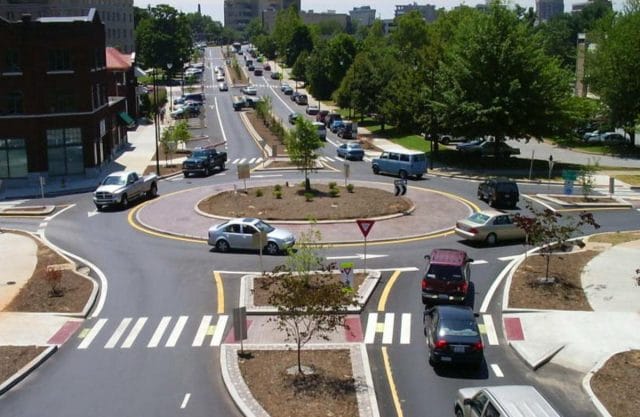
A roundabout in Shanghai, China; via Tauno Tõhk / 陶诺(Flickr)
![]()
In the 1980s cult classic, National Lampoon’s European Vacation, Clark Griswold drives into London, England with a beaming smile. Tucked into a yellow Austin Maxi hatchback, his wife and two children eagerly take in the sights and sounds of the new city. Then, without warning, Griswold endures a true American nightmare: he enters a roundabout.
Unable to get over into the left lane and exit, he helplessly circumnavigates the concrete orb for hours. Eventually, his repeated cries — “Hey look kids, there’s Big Ben! Parliament!” — grow increasingly more desperate, and he is driven to the point of mental instability.
Unfortunately, this is telling of most Americans’ opinion of roundabouts. As beacons of unfamiliarity, the roughly 3,700 circular traffic intersections in the U.S. are feared, avoided, and even loathed, often without good reason. It seems that every time traffic engineers propose to build a new one, there is protest and uproar.
Elsewhere, roundabouts are more revered: Australia has more than 10,000. France features 32,000. The UK not only boasts 25,000 (the most in the world, as a proportion of total road space), but maintains the “British Roundabout Appreciation Society,” a collective of grateful denizens who tout the roundabout as “an oasis on a sea of tarmac.”
Discover agrees: “The roundabout,” wrote the magazine in 2001, “is the single most important device ever created to help control traffic safely and smoothly.”
Here’s why: Using simple principles of physics, roundabouts dramatically reduce crash rates, as well as injuries and deaths. They diminish vehicle emissions. They are a more effective use of road space, and cost less to maintain than traditional four-way intersections.
And it’s time that America learns to love them.
Roundabouts: A History of Hatred
America’s fear of roundabouts is rooted in the invention’s history.
More than a century ago, city planners began to experiment with integrating large traffic circles in cities. Columbus Circle, built on the southwest corner of Central Park, New York in 1905, is largely acknowledged as the first of these, serving as a formidable (if not confusing) alternative to a four-way intersection. The concept spread, and by the mid 20th-century, many large, circular rotaries had had built across the United States, as well as throughout Europe and South America.
While these early traffic circles added aesthetic value to crowded cities, they were incredibly dangerous and impractical — mainly for one reason: entering traffic had the right of way, while circulating traffic had to yield. This “offside priority” rule led to high-speed merging and over-congestion which, in turn, increased the frequency of collisions. Some 40 years after being integrated, traffic circles had earned a negative reputation and largely fell out of favor — not just in the U.S., but internationally. Then, as quickly as they’d been written off, they made a comeback.
In 1966, Frank Blackmore, a city engineer in the UK’s Transport Research Laboratory, was looking for a way to optimize the flow of traffic at certain junctions, and decided to revisit the concept of traffic circles. Recognizing that they were inherently flawed but had a lot of potential, he pioneered the “modern roundabout” — the design that is largely in use today.
Modern roundabouts reversed the rule of older traffic circles in the sense that entering vehicles no longer had the right of way, and now had to yield to circulating traffic. They also significantly reduced entry speed: while older traffic circles were intended for speeds of 25+ mph, modern roundabouts employed curved entries that limited speeds to 15 mph. These simple changes would prove to be massively effective: within a decade, thousands of new roundabouts were constructed in England, and accident rates plummeted.
A “modern” roundabout, in which entering vehicles must yield to circulating traffic
While modern roundabouts flourished in popularity overseas, an American engineer named Leif Ourston resolved to bring them to U.S. soil as an alternative to ever-dangerous four-way intersections. There was one issue: Americans unanimously detested them, largely due to their negative associations with outdated, dangerous traffic circles. Similarly, the engineering community strongly opposed bringing modern roundabouts to America. They considered them a “radical” innovation.
A true rebel, Ourston launched his own engineering firm in 1984, then wrote a pleading letter to Frank Blackmore (the man who’d designed the modern roundabout in the U.K.):
“In 1941, Sir Winston Churchill asked America to join Britain in a struggle to protect democracy. We joined you and together we triumphed. Now, 45 years later, I am calling upon you to help me with a difficult struggle in which we are both engaged. We are trying to bring the British-style roundabout to the western hemisphere. The fighting is tough, the slogging is slow, and the resistance is stiff. In the spirit of Anglo-American cooperation, will you join us and lend a hand?”
On his own dime, Ourston flew Blackmore out to California and the two embarked on a tour around the state, trying to convince various transportation heads to build more roundabouts. Time after time, they were given the same response: roundabouts confused and frustrated American drivers, and were therefore impractical. Everywhere the duo went, surveys found that only around 20% of drivers were in favor of roundabouts; the rest were vehemently opposed.
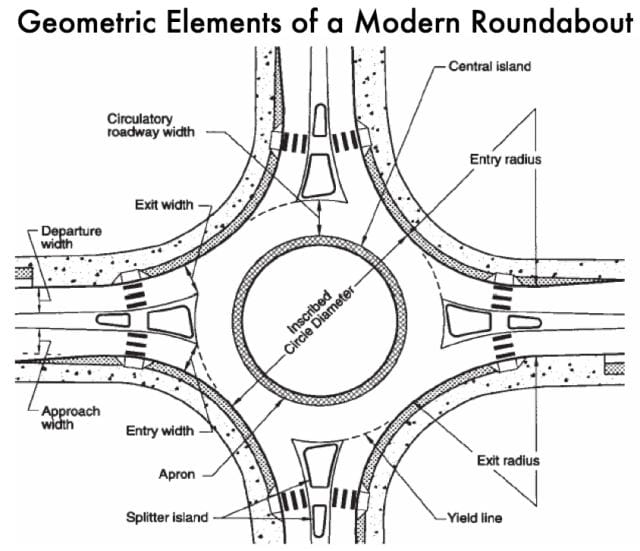
Throughout the late 80s, Ourston secured proposals to build roundabouts, only to have the projects cancelled at the last minute due to protests. Then, finally, in 1990, he succeeded in replacing two four-way intersections in Nevada with roundabouts.
When these roundabouts exhibited successful results, Ourston, armed with “statistical proof of safety,” was very gradually able to convince other municipalities to follow suit.
As we will demonstrate, there is ample “proof” that roundabouts are safer, better for the environment, and improve traffic flow. Yet, despite the many proven successes of roundabouts, America still hasn’t made strides to integrate them on a larger level. Today, nearly three decades after Ourston’s quest, only 3,700 roundabouts occupy our country’s roads.
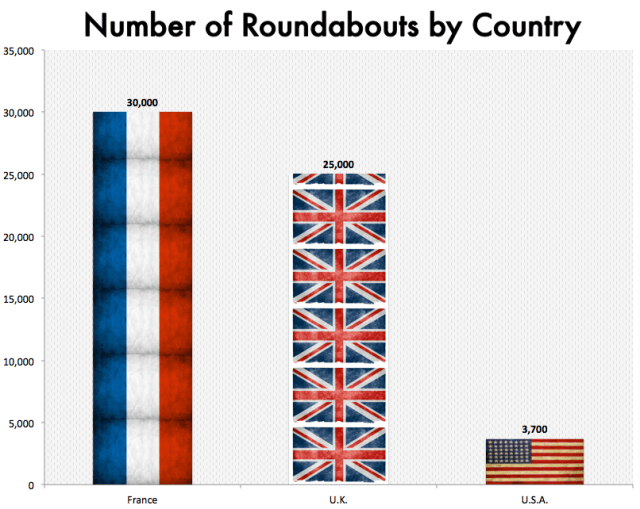
Priceonomics; data via Roundabouts USA
The United States has hardly given roundabouts a chance. There are some 4,092,000 miles of paved road in America (gauged with France’s 612,000, and the U.K.’s 245,000), yet we have nearly 10x fewer roundabouts than the latter. We maintain only 90 roundabouts per 100,000 miles of paved road, while France has 4,900, and the U.K. has a mind-boggling 10,200.
We have fervently avoided the integration of roundabouts — and it’s time we reconsidered this decision.
Here’s why.
Roundabouts Are Safer
According to data from the International Road Traffic Accident Database, some six million traffic accidents occur each year in the U.S.; of these, 40% happen in intersections.
Statistically speaking, intersections (both 4-way, and t-shaped) are deadly places: Based on data collected between 1998 and 2007, 21.5% of all traffic-related deaths, and 44.8% of all traffic-related injuries occur in intersections. On average, 9,000 people die and another 767,000 are injured in intersection collisions every year in the U.S.
Intersections may be convenient and familiar for drivers, but their inherent design allows for a proliferation of high-speed, high-impact crashes. Utilizing simple physics, roundabouts significantly mitigate these risks. Tom Vanderbilt, author of Traffic: Why We Drive the Way We Do, explains why:
“Roundabouts are typically built using what’s called ‘negative superelevation,’ meaning that water flows away from the center and also that the road slopes against the direction of a driver’s turn. As a result, any crashes in a roundabout take place at lower speeds and are thus less likely to be fatal…They also eliminate the left turn against oncoming traffic — itself one of the main reasons for intersection danger — as well as the prospect of vehicles running a red light or speeding up as they approach an intersection to ‘beat the light.”
Roundabouts reduce crashes by the very nature of their geometry. While traditional four-way intersections have 32 possible collision conflict points, roundabouts have only 8:
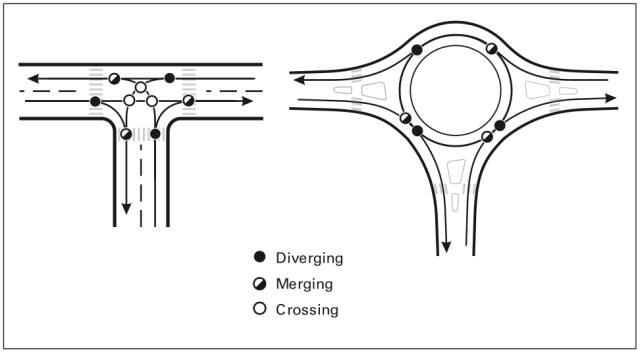
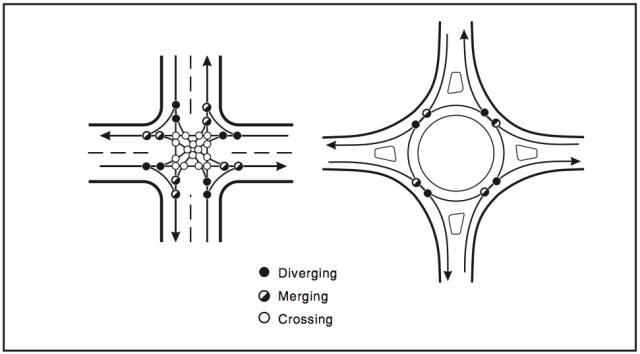
Collision conflict points: intersections vs. roundabouts; via The Federal Highway Administration
Interestingly, our fear of roundabouts also plays a role in making them safer: since they are unfamiliar to us, we are wary about entering them and are extra cautious. On the other hand, we’re accustomed to intersections, and more likely to take risks when driving through them.
So just how much safer are roundabouts are than intersections?
A 2001 report in the American Journal of Public Health selected 24 intersections that were converted into roundabouts in 8 different states, and analyzed the before and after crash data. In most cases, the time period (in months) was the same in the before and after periods; where it was not, the Bayes method was used for normalization. Researchers found that, overall, roundabouts reduce all crashes by 38% and reduce injuries by a whopping 76%.

Priceonomics; data via “Crash and Injury Reduction Following Installation of Roundabouts in the United States” (Retting, Persaud, Garder, Lord; American Journal of Public Health, 2001)
In addition to these reductions, researchers have found that roundabouts reduce fatal collisions by as much as 90%, and pedestrian/cyclist incidents by 40%, when gauged with traditional intersections.
The city of Carmel, Indiana presents another interesting case study. With 60 roundabouts, it has more than any other city in the United States — and, as a result, has seen an 80% reduction in injuries, and a 40% reduction in overall crashes.
International reports have produced similarly favorable results: roundabouts have been found to decrease car accident injuries in Australia (87%), France (78%), Amsterdam (71%), and the U.K. (39%).
Roundabouts Reduce Vehicle Emissions
Every year, Americans produce 7 billion metric tons of greenhouse gasses. It is estimated that 47-55% of these emissions come from motor vehicles. In the recent words of California’s governor, Jerry Brown, “the consequence [of global warming] are real” — and roundabouts can help make a difference.
In addition to being safer than intersections, roundabouts are also more forgiving on Mother Earth.
A study by a team of researchers at Kansas State University monitored the emissions of various vehicle pollutants at six sites with varying traffic flow: three intersections and three roundabouts. Twice daily (AM, PM), gas levels were captured and recorded. The results confirm that cars in roundabouts emit remarkably less pollutants than cars in intersections.
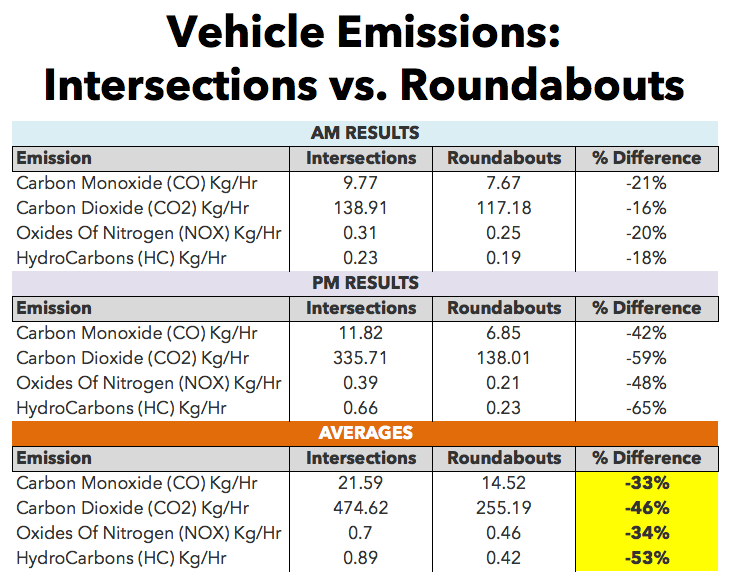
Priceonomics; data via “Impact of Modern Roundabouts on Vehicular Emissions” (Mandavilli, Russell, Rys; Kansas State University)
On average, carbon monoxide emissions decreased by 33%; carbon dioxide (which accounts for far and away the largest percentage of America’s pollution) is reduced by an astounding 46%. Other gasses (nitrogen oxide, and hydrocarbons) are cut by one-third, and one-half, respectively.
Tom Vanderbilt, an author and traffic expert, explains why:
“Accelerating from a dead stop is the least efficient thing a car’s engine can do. By reducing stop-start queuing—and eliminating it at ‘off-peak times,’ like the moments at 2 a.m. when you’re idling at a red-light at an near-empty intersection—roundabouts not only waste less time than traditional intersections but also less energy, as various studies have confirmed.”
With roundabouts, vehicle idle time is significantly reduced. Even when there is traffic in a roundabout (which isn’t uncommon during rush hour), they are still less damaging than stoplight intersections, which almost perennially have a queue of cars idling at any given moment. At most times of the day, roundabouts keep cars in constant motion, and eliminate the need to come to a full stop.
Roundabouts Improve Traffic Flow and Are More Efficient
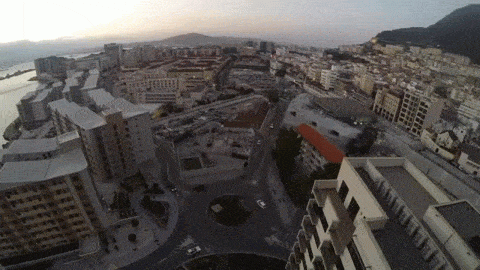
A common misperception about roundabouts is that they’re inefficient and always congested with traffic. This is simply not true: while roundabouts feature much slower speeds than intersections, they actually invite less traffic, and are more optimal for traffic flow.
In 2004, researchers decided to compare the operational performance of roundabouts with controlled intersections (those with either stop signs or traffic lights). For their study, 11 modern roundabouts and a variety of intersections in Kansas were monitored by camera.
The footage was sorted through using traffic engineering design software which analyzed it for a variety of metrics: average intersection delay, maximum approach delay (the amount of time it took a car to reach the intersection), 95% queue length (the queue length, in vehicles, that has only a 5% probability of being exceeded during the analysis time period), degree of saturation (how much demand an intersection is experiencing compared to its total capacity), proportion of vehicles stopped, and maximum proportion of vehicles stopped.
Here’s what they found:
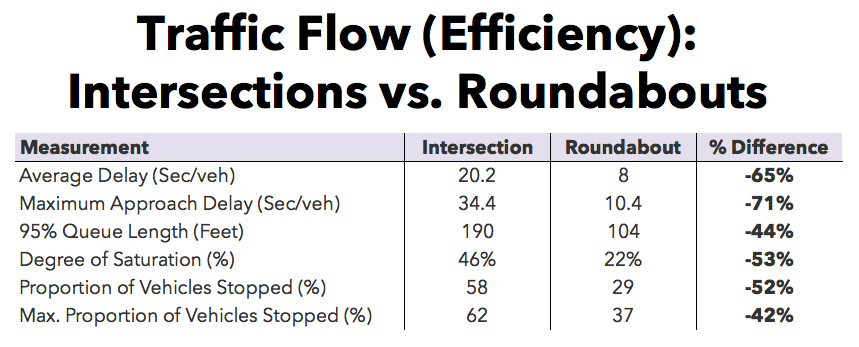
Priceonomics; data via “Operation Performance of Roundabouts: Phase II” (Mandavilli)
In every single metric, roundabouts outperformed intersections in terms of efficiency. Average delays were cut by 65%, no more that one-third of vehicles were not in motion at any given time, and the circle never went over 22% of its full capacity.
Roundabouts are, on average, less congested and more efficient than intersections; as such, they save drivers precious time. For instance, after the town of Golden, Colorado converted a series of signalized intersections to roundabouts in 1999, the average speed of commuters dropped by 10 mph on those sections, but “the time to travel the entire stretch of road dropped.”
It is not uncommon to read stories about American drivers going out of their way to avoid roundabouts — one California woman drove an extra 9 miles each day to do just that — but as the data shows, this behavior is unjustified. Roundabouts are often a quicker alternative to traditional 4-way intersections.
Going In Circles

Like any engineering or design implementation, roundabouts aren’t always the answer: some intersections are too small or too big, or have too much traffic volume for them to work effectively. But where they have instituted, roundabouts are safer, more environmentally-friendly, and more efficient than signalized intersections.
The benefits of roundabouts certainly don’t stop there. The “islands” they create are often stylized by urban planners, which improves aesthetics. They allow the elimination of ever-wasteful left-turn lanes (which are vastly underutilized on most roads), freeing up more space for bike lanes and landscaping. By negating the need for traffic lights, roundabouts also save an estimated $5,000 per year per intersection in electricity and maintenance.
Still, America has its reservations. Why?
According to journalist Stephen Beard, “The roundabout [has] flourished in Britain because it requires the British virtues of compromise and cooperation,” while “the U.S.’s more aggressive, confrontational culture may explain why the roundabout has not been more widely adopted by Americans.” Of course, this is tongue-in-cheek (Beard is a Brit himself).
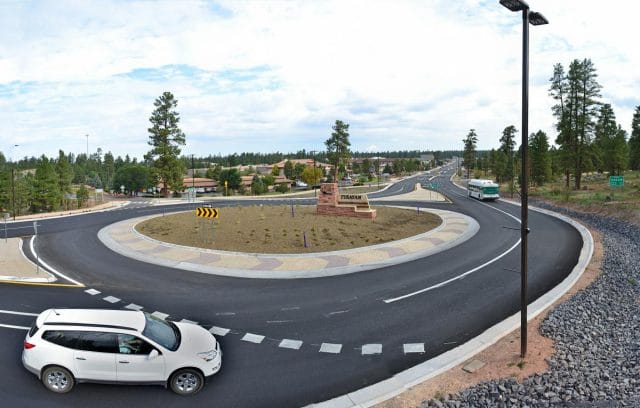
More likely, our detestation of roundabouts is a textbook case of availability heuristic — that is, when we think of roundabouts, we make a judgement based on the immediate thoughts and memories we associate with them. We think of Clark Griswold stuck in the never-ending mire of an old rotary, unable to escape the right lane. We are reminded of Homer Simpson fruitlessly circling Lambeth Bridge Roundabout for hours before swerving out in an act of desperation, nearly killing Queen Elizabeth II. And of course, we conjure images of older, much more dangerous traffic circles — many of which still operate on the East Coast — and assume that the new ones will be just as wicked.
But the solution to our intolerance, posits Tom Vanderbilt, ultimately lies in realizing that unfamiliarity does not equate to impracticality.
“Americans in general dislike ambiguity in traffic; we like wide roads with clearly demarcated lanes,” he tells us. “[Roundabouts] seem more dangerous in the moment because they demand more cognitive bandwidth, but we can only appreciate the safety statistics when we step back and think.”
For our next post, we investigate the dark origins of the conjugal trailer. To get notified when we post it → join our email list.
![]()
This post was written by Zachary Crockett. You can follow him on Twitter here.





